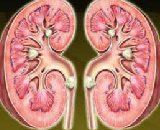Renal Fibrosis (RF)

Renal fibrosis, characterized by tubulointerstitial fibrosis and glomerulosclerosis, is the final manifestation of chronic kidney disease. Renal fibrosis is characterized by an excessive accumulation and deposition of extracellular matrix components. This pathologic result usually originates from both underlying complicated cellular activities such as epithelial-to-mesenchymal transition, fibroblast activation, monocyte/macrophage infiltration, and cellular apoptosis and the activation of signaling molecules such as transforming growth factor beta and angiotensin II.
Experimental models for renal fibrosis have identified a number of factors that contribute to renal scarring, particularly derangements of physiology involved in the autoregulation of glomerular filtration. This in turn leads to replacement of normal structures with accumulated extracellular matrix.
Organism species: Mus musculus (Mouse)
- Disease model DSI519Mu01 Mouse Model for Renal Fibrosis (RF) In Stock
- Disease model DSI519Mu02 Mouse Model for Renal Fibrosis (RF) In Stock
- Disease model DSI519Mu03 Mouse Model for Renal Fibrosis (RF) In Stock
- Customized Service n/a Tissue of Renal Fibrosis (RF) (If Necessary) Tissue Customized Service Offer
- Customized Service n/a Serums of Renal Fibrosis (RF) (If Necessary) Serums Customized Service Offer
Organism species: Rattus norvegicus (Rat)
- Disease model DSI519Ra01 Rat Model for Renal Fibrosis (RF) In Stock
- Disease model DSI519Ra02 Rat Model for Renal Fibrosis (RF) In Stock
- Disease model DSI519Ra03 Rat Model for Renal Fibrosis (RF) In Stock
- Customized Service n/a Tissue of Renal Fibrosis (RF) (If Necessary) Tissue Customized Service Offer
- Customized Service n/a Serums of Renal Fibrosis (RF) (If Necessary) Serums Customized Service Offer
Organism species: Cavia (Guinea pig )
- Disease model DSI519Gu01 Cavia Model for Renal Fibrosis (RF) In Stock
- Disease model DSI519Gu02 Cavia Model for Renal Fibrosis (RF) In Stock
- Disease model DSI519Gu03 Cavia Model for Renal Fibrosis (RF) In Stock
- Customized Service n/a Tissue of Renal Fibrosis (RF) (If Necessary) Tissue Customized Service Offer
- Customized Service n/a Serums of Renal Fibrosis (RF) (If Necessary) Serums Customized Service Offer
Organism species: Oryctolagus cuniculus (Rabbit)
- Customized Service n/a Model for Renal Fibrosis (RF) Disease Model Customized Service Offer
- Customized Service n/a Tissue of Renal Fibrosis (RF) (If Necessary) Tissue Customized Service Offer
- Customized Service n/a Serums of Renal Fibrosis (RF) (If Necessary) Serums Customized Service Offer
Organism species: Canis familiaris; Canine (Dog)
- Customized Service n/a Model for Renal Fibrosis (RF) Disease Model Customized Service Offer
- Customized Service n/a Tissue of Renal Fibrosis (RF) (If Necessary) Tissue Customized Service Offer
- Customized Service n/a Serums of Renal Fibrosis (RF) (If Necessary) Serums Customized Service Offer


